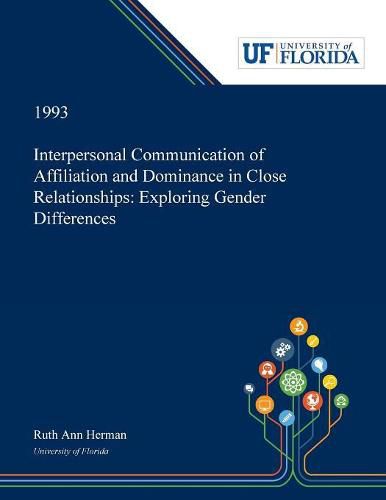Readings Newsletter
Become a Readings Member to make your shopping experience even easier.
Sign in or sign up for free!
You’re not far away from qualifying for FREE standard shipping within Australia
You’ve qualified for FREE standard shipping within Australia
The cart is loading…






Abstract: The purpose of this study was to increase the present understanding of gender differences in affiliative and dominant communication between men and women in close relationships. Forty-two heterosexual couples were tested separately and engaged in a videotaped conflictual interaction for 7 ½ minutes. Communication perceptions of this interaction were then examined in two ways. First, using Interpersonal Process Recall, the couples recorded their intentions, perceptions and reactions to the interaction in their own words. These recordings were then content-analyzed by trained raters using a standardized personality measure as their guide for coding. Second, couples completed the Interpersonal Adjective Scale-Revised created by Wiggins, Trapnell, and Phillips in 1988, which assessed perceptual differences between their own and their partners’ communication on affiliative and dominant dimensions. The Personality Attributes Questionnaire designed by Spence and Helmreich in 1978 was also used to determine the gender-role of each participant. It was hypothesized that men and women would perceive their own and their partners’ communication from frameworks of dominance and affiliation, respectively. The hypotheses were not supported. Instead, findings indicated that both men and women perceived affiliation to be the primary mode of communication for themselves and their partners. In addition, the predominant gender-role for the women on this sample was feminine. For the men, the predominant gender-role was androgynous. The relationship between participants’ gender-role orientation and the study’s findings is discussed, and recommendations for future research are made.
Dissertation Discovery Company and University of Florida are dedicated to making scholarly works more discoverable and accessible throughout the world. This dissertation, Interpersonal Communication of Affiliation and Dominance in Close Relationships: Exploring Gender Differences by Ruth Ann Herman, was obtained from University of Florida and is being sold with permission from the author. A digital copy of this work may also be found in the university’s institutional repository, IR@UF. The content of this dissertation has not been altered in any way. We have altered the formatting in order to facilitate the ease of printing and reading of the dissertation.
$9.00 standard shipping within Australia
FREE standard shipping within Australia for orders over $100.00
Express & International shipping calculated at checkout
Abstract: The purpose of this study was to increase the present understanding of gender differences in affiliative and dominant communication between men and women in close relationships. Forty-two heterosexual couples were tested separately and engaged in a videotaped conflictual interaction for 7 ½ minutes. Communication perceptions of this interaction were then examined in two ways. First, using Interpersonal Process Recall, the couples recorded their intentions, perceptions and reactions to the interaction in their own words. These recordings were then content-analyzed by trained raters using a standardized personality measure as their guide for coding. Second, couples completed the Interpersonal Adjective Scale-Revised created by Wiggins, Trapnell, and Phillips in 1988, which assessed perceptual differences between their own and their partners’ communication on affiliative and dominant dimensions. The Personality Attributes Questionnaire designed by Spence and Helmreich in 1978 was also used to determine the gender-role of each participant. It was hypothesized that men and women would perceive their own and their partners’ communication from frameworks of dominance and affiliation, respectively. The hypotheses were not supported. Instead, findings indicated that both men and women perceived affiliation to be the primary mode of communication for themselves and their partners. In addition, the predominant gender-role for the women on this sample was feminine. For the men, the predominant gender-role was androgynous. The relationship between participants’ gender-role orientation and the study’s findings is discussed, and recommendations for future research are made.
Dissertation Discovery Company and University of Florida are dedicated to making scholarly works more discoverable and accessible throughout the world. This dissertation, Interpersonal Communication of Affiliation and Dominance in Close Relationships: Exploring Gender Differences by Ruth Ann Herman, was obtained from University of Florida and is being sold with permission from the author. A digital copy of this work may also be found in the university’s institutional repository, IR@UF. The content of this dissertation has not been altered in any way. We have altered the formatting in order to facilitate the ease of printing and reading of the dissertation.